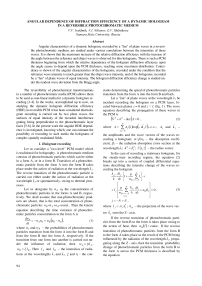Angular dependence of diffraction efficiency of a dynamic hologram in a reversible photochromatic medium
Автор: Ivakhnik V.V., Nikonov V.I., Shilnikova E.V.
Журнал: Компьютерная оптика @computer-optics
Рубрика: Технологии компьютерной оптики
Статья в выпуске: 24, 2002 года.
Бесплатный доступ
Angular characteristics of a dynamic hologram, recorded by a "fan" of plane waves in a reversible photochromatic medium, are studied under various correlations between the intensities of these waves. It is shown that the maximum increase of the relative diffraction efficiency with the increase of the angle between the reference and object waves is observed for thin holograms. There is such a PCM thickness beginning from which the relative dependence of the hologram diffraction efficiency upon the angle ceases to depend upon the PCM thickness, reaching some maximum distribution. Coincidence is shown of the angular characteristics of the holograms, recorded under the condition that the reference wave intensity is much greater than the object wave intensity, and of the holograms, recorded by a "fan" of plane waves of equal intensity. The hologram diffraction efficiency change is studied under the readout wave deviation from the Bragg angle. The reversibility of photochemical transformations in a number of photochromatic media (PCM) allows them to be used as non-linear media for a dynamic hologram recording [1-4]. In the works, accomplished up to now, on studying the dynamic hologram diffraction efficiency (HDE) in reversible PCM it has been considered that hologram recording is carried out by two plane waves, the surfaces of equal intensity of the recorded interference grating being perpendicular to the photochromatic layer faces [5-6]. In the present work the angular HDE dependence is investigated, knowing which, one can estimate the possibility of recording in such media the holograms of complex spatially modulated fields.
Короткий адрес: https://sciup.org/14058565
IDR: 14058565


